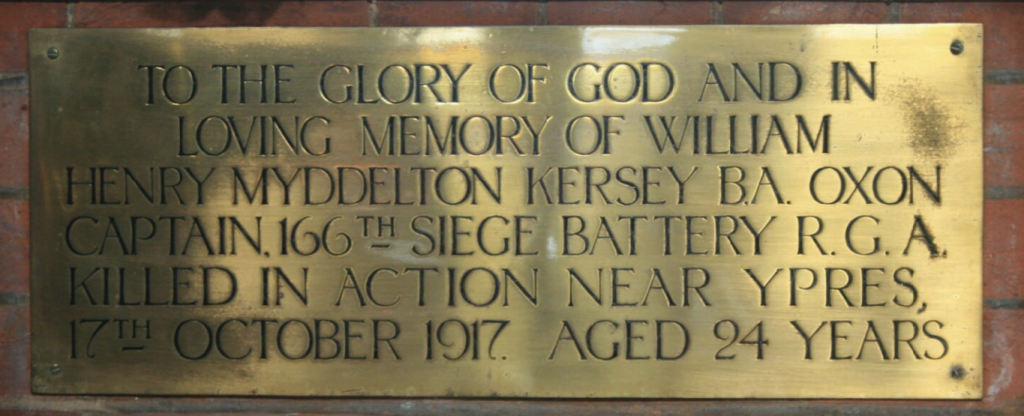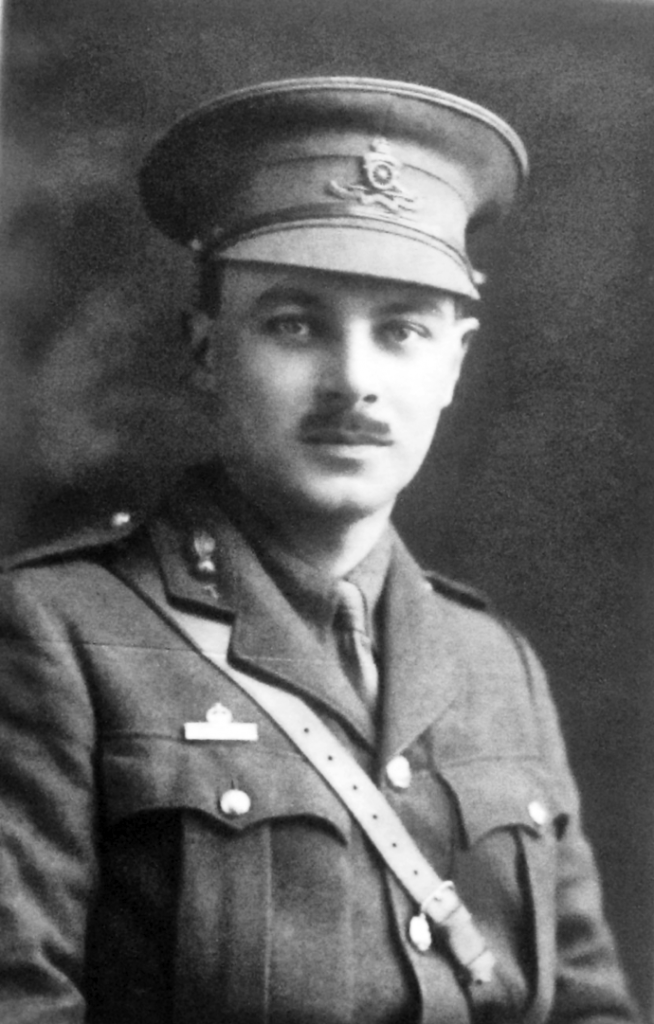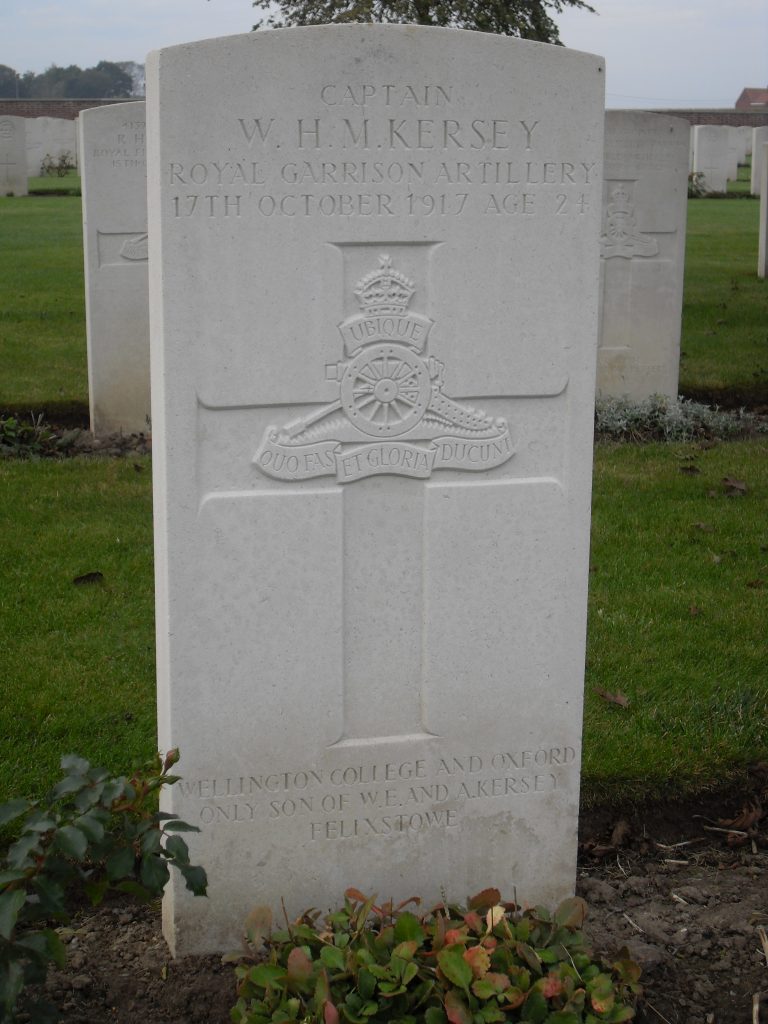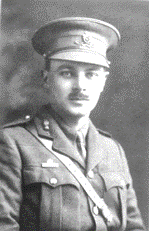Fact file:
Matriculated: 1911
Born: 4 December 1892
Died: 17 October 1917
Regiment: Royal Garrison Artillery
Grave/Memorial: The Huts Cemetery: X.C.15
Family background
b. 4 December 1892 in Ipswich as the only son (one sister) of William Edward Kersey (1859–1951) and Ada Laura Kersey (née Pegg) (1864–1938) (m. 1886). At the time of the 1901 Census the family was living at 41 Constitution Hill, Ipswich, Suffolk (four servants); by the time of the 1911 Census it was living at “Seagull House”, Felixstowe, Suffolk (four servants).
Parents and antecedents
Kersey’s father was a solicitor. He was the son of William Kersey (1809–1887), a farmer of 310 acres at Waldringfield on the Suffolk coast. At the time of the 1871 Census he also described himself as a worker of coprolyte (sic) (fossilized faeces) which he dug up presumably on his farm and sent to Ipswich for processing by the Fison Company into phosphate fertiliser. At his death in 1887 his estate was worth £23,306 19s 7d. (roughly £1.5 million in 2017).
Siblings and their families
Kersey’s sister was Marion Elizabeth (1898–1968), later McCandlish after her marriage in 1936 to Herbert McCandlish (1870–1957). McCandlish had previously been married (in 1910) to Frances Helen May Sutherland (1876–1936), one daughter.
Herbert McCandlish described himself as an engineer and in 1911 was the assistant manager of an explosives factory.
Education
Kersey attended Mr E.C. Paul’s Preparatory School, Orwell House, Walton, near Felixstowe, Suffolk (now defunct), from 1901 to 1906, then Wellington College, Berkshire, from 1906 to 1911, where he was a keen cricketer and became Head of his House. He matriculated at Magdalen as a Commoner on 17 October 1911, having passed Responsions in Hilary Term 1911. He took the First Public Examination in the Hilary and Trinity Terms of 1912 and then worked assiduously for a Pass Degree (Groups A1 [Greek and/or Latin Literature/Philosophy], B3 [Elements of Political Economy], and B4 [Law]), enabling him to take Finals more quickly than the College had anticipated. He took his BA on 11 July 1914, and after his death a Tutor wrote to his father that he “did his duty nobly while he was with us and he has done it even more nobly since”.
After leaving Oxford, Kersey was articled to S. Cozens-Hardy and Jewson, a firm of solicitors in Norwich. In a letter to Kersey’s father of 13 November 1917, President Warren said:
I had a real regard for him. He was quiet, modest, not pushing or showy or self-centred, but a very sterling fellow, and I am sure his loss is no small one. I remember well his coming and talking to me about the choice of his profession. I thought he showed very sound judgment, and a very admirable spirit. He was keen, always on the right side[,] and I was grateful for his influence.
In his reply of the following day, Kersey’s father wrote:
Of course I did so look forward to his joining me in my practice and his living companionship and assistance in the future was what I was longing for. I feel at times [that] all my interests in life have disappeared.
These feelings were endorsed by the Vicar of St John’s Church, Felixstowe, in an obituary that he wrote for the parish magazine: “The sudden breaking down of all those bright hopes which centre in an only son leaves a feeling of desolateness which the consolations of God alone can soften.”
War service
Kersey was 5 foot 11 inches tall, and as he had been a member of the Officers’ Training Corps at Wellington College, he was gazetted Second Lieutenant in the Essex and Suffolk Royal Garrison Artillery (Territorial Force) on 18 February 1915. He was sent, initially, to Beacon Hill, Harwich, in order to take a gunnery course there, and then, after passing in gunnery at Shoeburyness, he was sent to Stowmarket Anti-Aircraft Battery, which was situated at the back of the Explosive Works, where he served for some months. In January 1916 he was sent to France for three weeks to take a course on anti-aircraft gunnery, and on returning he was sent to Stowmarket to command an anti-aircraft battery.
On the night of 31 March 1916 his sentry suddenly warned him of the approach of a Zeppelin – as the telephone was not working he had had no previous warning of Zeppelins being in the neighbourhood. No time was lost, and the 2-inch guns were manned and very shortly in action. Although five high-explosive bombs were dropped c.75 yards from the searchlight, no damage was done – except for holes in a neighbouring field. The Zeppelin (L15) was hit twice and the local people were full of praise and said that the battery’s good gunnery had prevented the Explosive Works from being damaged. On 5 April 1916 the incident was mentioned in the House of Commons.
Kersey was promoted Lieutenant on 1 June 1916 and after passing another exam in anti-aircraft gunnery at Shoeburyness, he was transferred to the Regular Royal Garrison Artillery and sent shortly afterwards to 166th Siege Battery at Aldershot. After further training he was sent to Lark Hill, near Salisbury, and then Stork Cross Camp near Newbury, and thence to France on 12 September 1916 with the Battery, which was equipped with 4.6-inch howitzers. The Battery was assigned to 15th Heavy Artillery Group (HAG) on 14 September 1916, to 63rd HAG on 2 October 1916, to 12th HAG on 5 October 1916, to 8th HAG on 8 January 1917, to 46th HAG on 24 January 1917, to 35th HAG on 18 June 1917, to 73rd HAG on 9 September 1917, to 66th HAG on 12 September 1917, to 66th HAG on 12 September 1917 and to 30th HAG on 30 September 1917. From 18 October to 4 November 1917, Kersey’s Battery was part of the HAG Reserve.
Kersey was promoted Acting Captain on 5 March 1917 (London Gazette, no. 30,157, 29 June 1917, p. 6,487), and granted ten days’ leave in August 1917. He was killed, aged 24, together with his Commanding Officer, Acting Major Brabazon Thomas Disney (1883–1917), by a stray shell that fell on the dug-out near Ypres in which they were sleeping in the early hours of 17 October 1917. Ironically, this mishap occurred during a relatively quiet time in the Ypres Salient – the run-up to the final phase of the Third Battle of Ypres that is known as the Second Battle of Passchendaele (26 October–10 November 1917). On the following day, a brother officer, Captain Leonard Amis Hempson (1891–1971), also from Suffolk, who sounded genuinely shocked by the event, wrote a letter of condolence to Kersey’s family in which he said that “Myddleton was greatly loved and respected by all the men” and that “his death had taken all the heart out of them when I was down there this morning”. He continued that Kersey’s Battery had “had as rough a time as a Battery well could have” since the beginning of August, i.e. during Third Ypres, and that “it was your son alone who kept them together”. And he concluded: “But for a hitch in the arrangements the Battery would have been out of the position before last night. It was to be, I suppose, and we can only accept it.”
Kersey is buried in The Huts Cemetery (south-west of Ypres, near Dickebusch [Dikkebus]), Grave X.C.15, which has the inscription: “Wellington College and Oxford. Only son of W.E. and A. Kersey, Felixstowe.” He left £8,954 6s. On 9 July 1918, his father was sent part of the Zeppelin that had dropped off as a result of the accurate gunnery by his son’s battery.

Memorial plaque at St John the Baptist Church, Felixstowe, Suffolk
© WMR-5316
Bibliography
For the books and archives referred to here in short form, refer to the Slow Dusk Bibliography and Archival Sources.
Printed sources:
[Anon.], ‘Capt. W.H.M. Kersey, RGA’ [obituary], East Anglian Daily Times [between 17 October and 10 November 1917].
Archival sources:
MCA: Ms. 876 (III), vol. 2.
MCA: PR 32/C/3/756–759 (President Warren’s War-Time Correspondence, Letters relating to W.H.M. Kersey [1911–17]).
OUA: UR 2/1/75
WO95/5494 (Folios 301–553).
WO374/39425.



